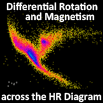Speaker
Kwing L. Chan
(Department of Mathematics, Hong Kong University of Science & Technology)
Description
Rotation exerts very significant effects on convection zones of stars. The
phenomenology consists of two types: differential rotation and large‐scale long‐lived
vortices. Both types exhibit prominently in outer planets of our solar system; these
planets possess outer convective layers and rotate fast. Differential rotation
appears in the form of multiple wind bands on Jupiter and Saturn, and occurs as broad
equatorial sub‐rotation in Uranus and Neptune. Among long‐lived vortices, the Great
Red Spot, White Ovals on Jupiter, and the Great Dark Spot on Neptune are famous.
These are anticyclones, but many other large vortices, both cyclonic and
anticyclonic, present. The only star we can observe differential rotation directly is
the Sun, which shows a super‐rotation band around the equator. However, we know that
the ranges of rotation rates
and convection zone properties are very wide among stars. It is reasonable to expect
that stars can display rotational phenomena at least as broad as those on the outer
planets. What are the physical conditions that determine the different forms of
differential rotation and the formation of different types of long‐lived vortices?
With the progress of numerical simulation of rotating convection made in the last 20
years, a unifying picture based on simple characteristic parameters is emerging. We
are going to discuss the numerical experiments and the derived conclusions.
Author
Kwing L. Chan
(Department of Mathematics, Hong Kong University of Science & Technology)

